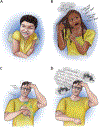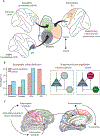Tourette syndrome: clinical features, pathophysiology, and treatment
- PMID: 36354027
- PMCID: PMC10958485
- DOI: 10.1016/S1474-4422(22)00303-9
Tourette syndrome: clinical features, pathophysiology, and treatment
Abstract
Tourette syndrome is a chronic neurodevelopmental disorder characterised by motor and phonic tics that can substantially diminish the quality of life of affected individuals. Evaluating and treating Tourette syndrome is complex, in part due to the heterogeneity of symptoms and comorbidities between individuals. The underlying pathophysiology of Tourette syndrome is not fully understood, but recent research in the past 5 years has brought new insights into the genetic variations and the alterations in neurophysiology and brain networks contributing to its pathogenesis. Treatment options for Tourette syndrome are expanding with novel pharmacological therapies and increased use of deep brain stimulation for patients with symptoms that are refractory to pharmacological or behavioural treatments. Potential predictors of patient responses to therapies for Tourette syndrome, such as specific networks modulated during deep brain stimulation, can guide clinical decisions. Multicentre data sharing initiatives have enabled several advances in our understanding of the genetics and pathophysiology of Tourette syndrome and will be crucial for future large-scale research and in refining effective treatments.
Copyright © 2023 Elsevier Ltd. All rights reserved.
Conflict of interest statement
Declaration of interests KAJ reports receiving fellowship funding from the National Science Foundation and travel grant awards from the International Congress of Parkinson's Disease and Movement Disorders. AG has received grant funding from the National Institutes of Health (NIH; R01NS096008) and the National Science Foundation (NSF PECASE 1553482); support from the Tourette Association of America; device donations from Medtronic under an NIH contract; and serves as a board member of the Brain Computer Interfaces Society. KDF reports receiving research support and fellowship support from Medtronic and Boston Scientific and research support from Functional Neuromodulation. CRB has received support from the NIH (UH3 NS119844) and has served as a consultant for NeuraModix. MSO serves as a medical advisor for the Parkinson's Foundation; has received research grants from NIH, Parkinson's Foundation, the Michael J Fox Foundation, the Parkinson Alliance, Smallwood Foundation, the Bachmann-Strauss Foundation, the Tourette Syndrome Association, and the UF Foundation; has received support for research by NIH (R01 NR014852, R01NS096008, UH3NS119844, and U01NS119562); and is principal investigator of the NIH R25NS108939 Training Grant. All other authors declare no competing interests.
Figures



Comment in
-
Neurosurgical lesioning for Tourette syndrome - Authors' reply.Lancet Neurol. 2023 Apr;22(4):292-293. doi: 10.1016/S1474-4422(23)00079-0. Lancet Neurol. 2023. PMID: 36931795 No abstract available.
-
Neurosurgical lesioning for Tourette syndrome.Lancet Neurol. 2023 Apr;22(4):292. doi: 10.1016/S1474-4422(23)00078-9. Lancet Neurol. 2023. PMID: 36931796 No abstract available.
References
-
- Gilles de la Tourette G. Étude sur une affection nerveuse caractérisée par de l'incoordination motrice accompagnée d'écholalie et de coprolalie. Arch Neurol, 9 (1885), pp. 19–42.
-
- Scharf JM, Miller LL, Gauvin CA, Alabiso J, Mathews CA, Ben-Shlomo Y. Population prevalence of Tourette syndrome: a systematic review and meta-analysis. Mov Disord, 30 (2015), pp. 221–228. - PubMed
-
- Levine JLS, Szejko N, Bloch MH. Meta-analysis: adulthood prevalence of Tourette syndrome. Prog Neuropsychopharmacol Biol Psychiatry, 95 (2019), Article 109675. - PubMed
-
- Garcia-Delgar B, Servera M, Coffey BJ, et al. Tic disorders in children and adolescents: does the clinical presentation differ in males and females? A report by the EMTICS group. Eur Child Adolesc Psychiatry (2021). - PubMed
Publication types
MeSH terms
Grants and funding
LinkOut - more resources
Full Text Sources
Medical
Miscellaneous

